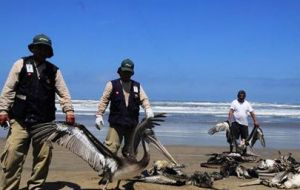MercoPress. South Atlantic News Agency
Warmer waters and lack of food most probable cause of pelicans’ death in Peru
 Hundreds of dead pelicans and dolphins have appeared along the northern coast of Peru (Pic by Efe)
Hundreds of dead pelicans and dolphins have appeared along the northern coast of Peru (Pic by Efe) The increase in water temperature to the north of Peru kept away the schools of fish on which marine birds feed causing the massive death of pelicans recorded in that area, which could extend to other parts of Peru, if conditions persist.
Public health and environmental authorities said at a press conference in Lima that warmer waters in the Pacific can be tracked to the massive mortality which was caused by the influx of warm sea currents from Australia and Ecuador.
This alteration of the marine ecosystem caused anchovies, the basic food of pelicans to move to other less warmer waters thus causing the massive death of over 5.000 pelicans tin the last few weeks.
A similar situation but with dolphins of which an estimated 900 appeared dead along the northern coast of Peru, is believed to be behind the tragedy, although investigations are still ongoing.
“Warmer waters are modifying the references of the ecosystem”, said the deputy chief from the Peruvian Environment Ministry, Gabriel Quijandria. He added that this has caused a natural alteration in the distribution of anchovies and other species that have migrated which caused “a fall in the availability of food mainly for pelicans and blue footed boobies”.
Last weekend the Peruvian government declared a sanitary alert along the northern coast and recommended people to abstain from going to the hundreds of kilometres of beaches, while the investigation into the death of pelicans and dolphins was ongoing.
A similar event was recorded in 1997 when hundreds of dead pelicans were found along the northern coast of Peru given the scarcity of anchovies, scared away by the warm waters from El Niño climatic phenomenon. Anchovies breed mainly along the coast of Peru and Chile because of the abundance of nutrients caused by the clash of warm and cold currents.
Anchovies are also the main input for fish meal of which Peru is the world’s leading producer and exporter.
However Quijandria said it was too premature to talk about the presence of the El Niño since the current warming of the Pacific coastal waters still has no definitive references. But “if conditions persist, it is probable that the impact will extend all along the coast during autumn, which means the death numbers could increase and involve other marine species”.
The post mortem tests of the pelicans did not show the presence of the feared “bird flu”, which involves risks for human health.
Quijandría went further and said that consumption of fish and sea food, which had dropped recently because of the fears of contamination, involves no risk for humans.
Likewise the possible impact on the Peruvian fish industry of the warmer waters, the Minister said that for the moment it presents no risk, since the Peruvian fleet is catching in the high seas in deep waters far from the coast line.
Furthermore the warmer water phenomenon is taking place to the north of Peru and in “the south things are very normal” said Jorge Vigil chief economist and statistics officer at the largest Peruvian fishing company.
As to the dolphins there are no indications of bacteria infections, heavy metals or pesticides’ contamination.
Quijandria went further and said that based on the corpses analyzed “it is not possible to associate the death of dolphins with the seismic exploration activities in the area”. US company BPZ Energy is looking for oil offshore north Peru.
The company said the deaths were reported before the seismic tests during the month of February, which “comply with all international standards in marine safety”.
However the local NGO Orca linked the deaths directly to the 3D seismic activity from oil companies saying forensic studies showed the dolphins had died because of “acute sound waves”.
Carlos Yaipen, head of Orca said that 30 dead dolphins’ tests showed they had bubbles in their organs and circulatory system, haemorrhages in ears and simple fractures of inner-ear bones.
“Dolphins suffered a severe case of acute decompression syndrome, caused by gas-embolic traumatism, which is gas bubbles in all the blood system and caused by the sound impact”, underlined Yaipén.




Top Comments
Disclaimer & comment rulesCommenting for this story is now closed.
If you have a Facebook account, become a fan and comment on our Facebook Page!